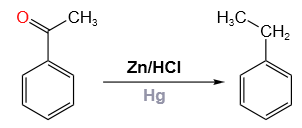The compound that does not give an iodoform test is:
1. 3-Pentanone
2. 2-Pentanone
3. Ethanol
4. Ethanal
A molecule among the following that does not give Claisen condensation reaction is:
1.
2.
3.
4. None of the above
Ethylbenzene is obtained from phenyl methyl ketone by using:
1. Zn–Hg+HCl
2. LiAlH4
3. KMnO4
4. None of the above
Acetaldehyde reacts with semicarbazide to yield the following as a product:
| 1. | \( {CH_3CH=NHNH_2} ~\) |
| 2. | \({CH_3CH=NCONHNH_2}~~~\) |
| 3. | \({CH_3CH=NNH-CO-NH_2}~~~~~\) |
| 4. |  |
Cyanohydrin of which of the following compounds on hydrolysis gives an optically active product:
1. HCHO
2.
3.
4. All of the above
Clemmensen reduction reaction is:
| 1. |  |
| 2. | \(C_6H_5-CO-CH_3 + NH_2NH_2 \xrightarrow{C_2H_5ONa}\\ C_6H_5CH_2CH_3\) |
| 3. | \(CH_3COCH_3 + 4HI \xrightarrow{\text{Red. P}} CH_3CH_2CH_3\) |
| 4. | All of the above |
Ethyl benzoate can be prepared from benzoic acid by using:
1. Propyl alcohol
2. Ethyl alcohol and dry HCl
3. Ethyl chloride
4. Sodium ethoxide
RCHO and NH2NH2 react with each other in an acidic medium. The product obtained is:
1. RCON3
2. RCH=NH
3. RCH2NH2
4. RCH=NNH2
The hydrolyzed product of an ester, when reduced by \(\mathrm{LiAlH}_4\), gives:
1. Two alcohols
2. Two aldehyde
3. One acid and one alcohol
4. Two acids
Intermediates formed during the reaction of
with and KOH are:
1. RNHCOBr and RNCO
2. RCONHBr and RNCO
3. RNH-Br and RCONHBr
4. RCON






